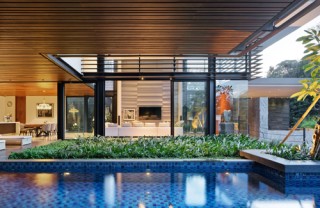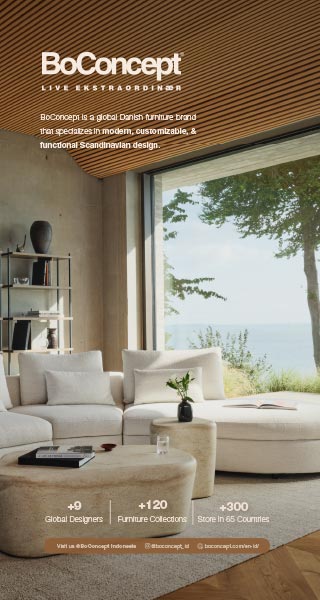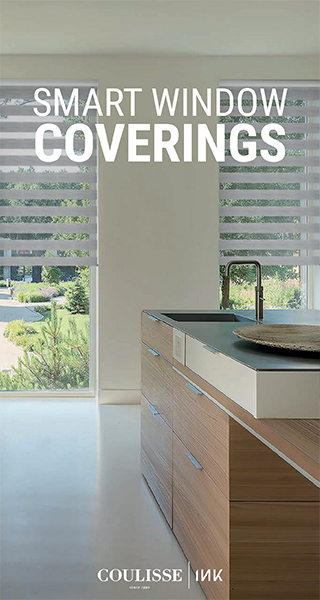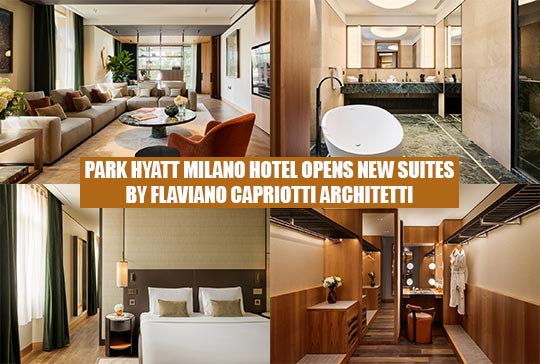
PARK HYATT MILANO HOTEL OPENS NEW SUITES BY FLAVIANO CAPRIOTTI ARCHITETTI
Published by Sugar & Cream, Thursday 13 June 2024
Images courtesy of Park Hyatt
Timeless Hospitality Spaces: An Iconic Hotel, Designing Spaces with Discreet, Whispered Luxury
Amid the 19th-century backdrop of Park Hyatt Milano — a luxury 5-star hotel just steps from the Milan Cathedral — Flaviano Capriotti Architetti creates the project for the new rooms, whose character, services, and fascination express the sense of high-end hospitality. Special mention goes to the three signature suites — Duomo, Montenapoleone, and Brera — and the Solferino and Fiori Chiari suites.

Having already designed the exclusive ‘Mio Lab’ cocktail bar and the ‘Pellico 3’ fine dining restaurant at Park Hyatt Milano, Capriotti adheres to the heritage and modern nature of the Italian post-war design masters for the new suites. Enhancing traditional materials and favouring soft, neutral shades, he creates welcoming, comfortable suites with a discreet, timeless, whispered luxury. Milan and its essence are found at the centre of the project, underlining the profound ties between Park Hyatt Milano, which just celebrated its 20th anniversary, and the history and culture of the city.
The Concept: Hints of Literature and Design
This visual narrative blends history, design, literature, and poetry, with the project for the hotel’s three signature suites growing out of interwoven suggestions. ‘The hotel is located in a rather dense urban area with a beautiful view of the Galleria, allowing guests to stay within a shell in the city centre, protected from the external world,’ says the architect. The Brera suite is located on the first floor, while the Montenapoleone and Duomo suites are situated on the sixth floor, with terraces that open out directly onto the sky in line with other city roofs. ‘This glimpse of sky blue, which in Milan has unique colours ranging from cerulean blue to amber red, reminded me of a passage in “The Betrothed”, an Italian historical novel by Alessandro Manzoni, in which Renzo, fleeing from Milan, takes refuge in a country house. Waking up in the morning, he finds himself looking at the light of the sunrise. The clear sky welcomes him,’ says the architect. He continues, ‘This is a passage that I have always loved due to Manzoni’s extraordinary ability to transform the written text into a powerful, vivid image. The sense of peace in those lines, wrapped in a love for the panoramas of Lombardy, was the start of a journey that carried me to the suites.’

Presented by Som Santoso
The Three Signature Suites: Duomo, Montenapoleone, and Brera
Flaviano Capriotti Architetti outlines a deeply conceptual project, preserving the idea of simple and refined middle-class modernity, where the high quality of the materials, functionality, and a clear perception of the spaces, play a key role. While with different sizes, the Duomo, Montenapoleone and Brera signature suites bear the same structural, material, and stylistic mark.
Upon entering, we are immersed in spacious rooms enwrapped by soft, welcoming nuances, where the hallways allow the gaze to travel over the entire area of the suite, whose positive and negative spaces allow for continuous interaction between inside and outside. Warm, welcoming materials such as dark brushed solid oak outline the various environments, alternating with fine Verde Alpi marble in a game of balance that enhances the textiles and furnishings. Among these — in addition to the majority made to the architect’s design — designer items by Franco Albini, Luigi Caccia Dominioni, Angelo Mangiarotti, Gio Ponti, Ignazio Gardella, and Enzo Mari stand out.
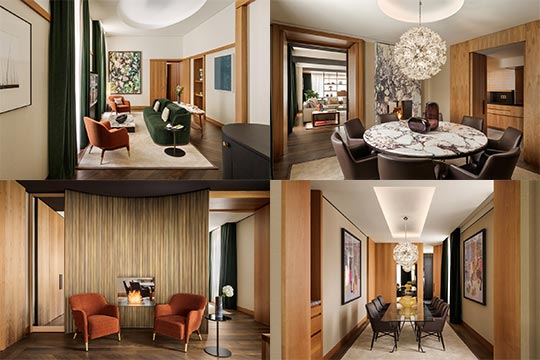
In a nod to the celebrated ancient art of silk production between Milan and Lake Como, the architect chose to cover the walls of the suites with pearl-grey silk wallpaper, interspersing it with Italian blond walnut wainscotting, a traditional material used here in its natural, soft, opaque shade, which highlights the true essence of the wood. In every suite, neutral shades make room for occasional touches of yellow and orange, recalling undertones in the twilight sky, with the recurring use of petroleum green in some of the furnishings, a simple yet sophisticated colour commonly used for interiors in Milan. A fundamental aspect is the lighting. ‘The quality of the light plays a critical role. It should be warm and create the right shadows and accents. A lighting system should not be perceived, precisely because it should enwrap guests softly, precisely, and naturally,’ the architect explains.
Structure and Features of the Suites. Space, Balance, and Terraces Overlooking the City
In the suites on the top floor, Capriotti has defined a hybrid zone between indoors and outdoors that is designed to be recognized. ‘In contrast to the other ceilings in the suite, the ceiling is made of wood, as if it were a cell of space between indoors and outdoors,’ he explains.
Located on the sixth and last floor of the hotel, the Montenapoleone and Duomo suites have terraces and living rooms with large veranda-style areas so that their relaxing atmosphere can also be enjoyed from inside. Believing that ‘every function needs its space, symmetry, and visual axes,’ the architect has traced out a clear, functional layout. The living area opens on one side of the suite, while the other side is dedicated to the terrace, which, in full style, allows guests to stay in the centre of Milan discreetly, spending evenings out Park Hyatt doors, surrounded by comfortable seating and sofas, as well as luxuriant greenery.
The Montenapoleone suite has a floor area of 180 m2, and a 35 m2 terrace, and with the two bedrooms also connected to terraces, the total area of the suite reaches 260 m2. The Duomo suite owes its name to the view of the Madonna statue from the 30-m2 terrace, which also has an area for relaxing and a Jacuzzi. The suite occupies an area of 130 m2 and connects to another suite with a terrace and bedroom of about 40 m2.
The rational symmetry of the spaces, with entrances at the centre of the rooms, breaks down only in the area dividing the living room from the dining room. Here, there is a double-sided fireplace with a concave side made of bronze and the back in marble. The mastery of Italian design is found in items such as bookcases by Albini, armchairs by Caccia Dominioni, marble console tables by Mangiarotti, armchairs by Gio Ponti, and tables by Enzo Mari.
The ample walk-in closet, fitted with a vanity station with a leather seat, is joined by a bathroom clad in brushed Verde Alpi marble, which contrasts with the polished Bianco Venezia marble. The environment creates a perfect backdrop for the relaxing bathtub or steam shower, which is capable of recreating the steam of a Turkish bath. Designed with the same style and arrangement, yet located on the first floor of the building, the Brera suite — which covers 100 m2 — has stately ceilings 4 metres high.
Facing the glass dome of the 19th-century courtyard, and the beating heart of the hotel, the Brera suite offers a romantic and suggestive view. Another common element is the distinctive approach to art. The suites contain works previously owned by the property and new purchases aimed at the Italian character, alternating with sculptures by artists such as Mattia Bosco, and painted works by Natale Addamiano and Santeri Tuori.
Also located on the first floor of the hotel are the connecting Solferino and Fiori Chiari suites, for a total floor area of 140 m2. Equally spectacular, the two suites feature the same materials as the three signature suites, such as Green Alps marble, which adorns the surfaces in the bathrooms. The Fiori Chiari suite has a balcony overlooking Via Mengoni.
FACTS AND FIGURES
Architectural and interior design: Flaviano Capriotti Architetti
Furnishings: Poliform, Cassina, Molteni, Driade, Agape Casa, Azucena,
Textiles, wallpaper and finishes: Dedar, Vescom, Domenico Mori, Rigo Marmi.
Lighting: Flos, Venini
 1.05K
23/12/2025
1.05K
23/12/2025
SÉANCE, A REFLECTION ON ADRIAN GAN COUTURE’S 40 YEARS IN FASHION
Step into SÉANCE, a reflection on Adrian Gan Couture’s 40 years in fashion—where each gesture is deliberate and every detail refined with impeccable...
read more 580
23/12/2025
580
23/12/2025
OPTIK SEIS X LONGCHAMP EYEWEAR: VERT LUMIÈRE MOMENT
A luminous fashion moment by Optik Seis and Longchamp Eyewear, where Parisian elegance meets a contemporary lifestyle experience at Senayan City.
read more 10.98K
03/12/2025
10.98K
03/12/2025
LIVING DIVANI ILLUMINATES THE FESTIVE SEASON IN SHADES OF DEEP RED AND LUMINOUS SILVER
Living Divani illuminates the festive season in shades of deep red and luminous silver, reimagining its iconic designs with festive radiance.”
read more 10.67K
26/11/2025
10.67K
26/11/2025
MOROSO AT ARTVERONA 2025: DESIGN AS DIALOGUE
Design as language – Moroso’s presence at the heart of ArtVerona’s 20th Edition
read more 81.54K
10/01/2025
81.54K
10/01/2025
W RESIDENCE IN SOUTH JAKARTA BY MICHAEL CHANDRA
Michael Chandra, founder of MNCO Studio Design has created the W Residence with an aesthetically pleasing, practical, and pleasant home from all...
read more 44.44K
11/07/2025
44.44K
11/07/2025
PELUNCURAN PERDANA LEGANO HOME MENGGANDENG AGAM RIADI DI ST REGIS RESIDENCE JAKARTA
Peluncuran perdana LEGANO HOME menggandeng Agam Riadi di St. Regis Residence Jakarta: menyatukan kemewahan dan jiwa dalam sebuah ruang.
read more



